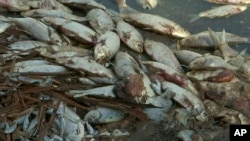A worsening drought is pushing parts of eastern Australia towards a “Fish Armageddon,” according to senior politicians.
With not much rain on the horizon, as well as record low river levels, there are fears eastern Australia will witness more fish dying at a higher rate than last summer.
A million fish died in January at Menindee, 1,000 kilometers west of Sydney, when a sudden drop in temperature caused algae to die. As the algae decomposed, oxygen was sucked out of the river, suffocating marine life.
Farmers and conservationists accused the state government of allowing cotton growers to drain too much water from the Murray-Darling River Basin, one of Australia’s key waterways. Officials, though, blamed a worsening drought. They have announced a multimillion dollar fish rescue plan to help avert an “ecological disaster.”
Modern Noah's Ark
The New South Wales Agriculture Minister Adam Marshall says vulnerable native fish will be relocated from the river to hatcheries for safety.
“I cannot sugar-coat it, it will be the equivalent of a ‘Fish Armageddon’ in New South Wales this summer, and I say that based on all the evidence. We will use hatcheries like this to create a modern-day Noah’s Ark for native fish species in New South Wales,” Marshall said.
The fish will be kept in captivity until river conditions improve.
Environmental groups, however, say changes are needed to water policy and management to improve flows to ensure “living, functioning” rivers.
Playing God?
Paul Humphries, an ecologist at Charles Sturt University, believes the Noah’s Ark plan probably will not work.
“It is a terrible choice because it was actually floods that caused the problem that Noah was trying to solve and here we are talking about droughts. It is also, I think, a problem because Noah was essentially being instructed by God and in some ways we are playing God with this sort of stuff,” Humphries said.
Australia is the world’s driest inhabited continent. Scientists are warning that climate change not only threatens national treasures such as the Great Barrier Reef, but also critical river systems that sustain the nation’s agriculture.








